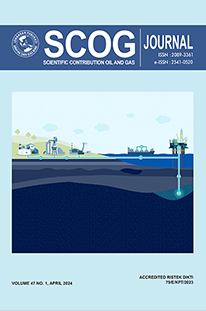Optimization of Heavy Key Composition of Distillate in Deisobutanizer Column Using Aspen Hysys with Flow Rate Reflux and Reboiler Temperature in Alkylation Unit at Company PEP
DOI:
https://doi.org/10.29017/SCOG.47.1.1609Keywords:
distillation, optimization, heavy key in distillate, energy savingAbstract
The mass fraction of specific components is used to determine the product quality in distillation column process. Therefore, there is a need for sophisticated optimization strategies to identify ideal reflux flow rates and reboiler temperatures during operation. In distillation column, the most influential variables are reflux flow rate and reboiler temperature, which means the quantity and quality of distillate heavy fraction must remain below 3%. Simulation through Aspen Hysys identified optimal operating conditions at a 200 tons/day reflux flow rate and reboiler temperature of 72.58°C, decreasing from 3.38% to 2.19% by company standards. Following this optimization, an analysis of energy savings was conducted to compare actual field conditions and optimization at energy consumption levels of 2,989 kW and 1,688 kW, respectively. Energy savings were 1,301 kW in deisobutanizer column, downstream equipment, and depropanizer column feed pump. The energy required for deisobutanizer column pump was reduced from 0.907 kW to 0.88 kW after optimization, with a significant decrease in depropanizer column. The results showed an overall figure of the positive impact of optimizing operations in the central distillation column.
References
Biyanto, T.R. 2007. Genetic Algorithm for Optimization of Energy Consumption in Methanol-Water Distillation Column Process. Journal of Electrical Engineering Volume 7, Number 1.
Biyanto, T. R., Widjiantoro, B. L., Jabal, A. A., & Budiati, T. 2010. Artificial Neural Network Based Modeling and Controlling of Distillation Column System. International Journal of Engineering, Science and Technology Vol. 2, No. 6, 177-188.
Christie, J., & Geankoplis. 1983, “Transport Process and Unit Operationâ€, PTR Prentice- Hall Inc, Englewood Cliffs, New Jersey.
Column Dictate. 2014. Process Equipment 2 Introduction to Distillation Column. PEM Akamigas Cepu.
Central Bureau of Statistics. 2021. Biofuel and domestic fuel gas statistics 2020. Jakarta: Central Bureau of Statistics.
Enweremadu, C. 2012. Energy Conservation in Ethanol-Water Distillation Column with Vapour Recompression Heat Pump, Distillation-Advances from Modelling to Applications. South Africa: Intech.
General Directorate of Foreign Trade. 2021. Import Statistics of Gas and Other Fuels 2020. Jakarta: Ministry of Trade.
General Directorate of Oil and Gas. 2021. Indonesian Oil and Gas Statistics 2020. Ministry of Energy and Mineral Resources.
Khairani, A. 2020. Improvement of gasoline quality using alkylation process. Journal of Chemical and Industrial Engineering.
Lucia, A., & McCallum, B. R. 2010. Energy targeting and minimum energy distillation column sequences. Computers and Chemical Engineering, 34(6), 931–942. http://doi.org/10.1016/j.compchemeng.2009.10.006
Mc Cabe, Warren L, Julian C. Smith, & Peter, H. 1987. "Chemical Engineering Operations", fourth edition Erlangga. Jakarta.
Moudy, A. V. 2016. Optimize depropanizer column product quality by changing controller set points at reflux and steam reboiler flow rates.
Muhammad Fuad. 2013. “Simulation of Distillation Boiling Point Distribution TBP and Hempel using the Riazy Math Modelâ€, fourth edition LEMIGAS. South Jakarta.
Nofrizal, Rosmayati, L., & Andriani Y. 2013. “A Rapid Gas Chromatoghraphy Method for Simultaneous Determination of L.P.G Compoundsâ€, fourth edition LEMIGAS. South Jakarta.
Patompong, P., et al. 2018. CFD Simulation on the Effect of Evaporator Length and Refrigerant Charge on the Performance of HCFC22 Split Type Air Conditioner. Energy Procedia, 152, 1072-1078.
Pla-Franco, J., Lladosa, E., Loras, S., & Montón, J. B. 2015. Approach to the 1-propanol dehydration using an extractive distillation process with ethylene glycol. Chemical Engineering and Processing: Process Intensification, 91, 121–129. http://doi.org/10.1016/j.cep.2015.03.007
PT. PEP. 2010. “Desing Data Sheet and Process Flow Diagram (PFD).
RWTUV. (2005). Distillation: Principles, Control & Troubleshooting. Dubai.
Robbins, L. 2011. Distillation Control, Optimization, and Tuning Fundamental and Strategies. Taylor & Francis Group.
Sudjana. 1996, "Regression and Correlation Analysis Techniques", Tarsito Bandung.
Syahrir, I. 2020. Analysis of Indonesia's natural gas industry: Challenges and Prospects. Indonesian Journal of Economics and Development.
Sorensen, E. 2014. Principles of Binary Distillation. Distillation: Fundamentals and Principles. http://doi.org/10.1016/B978-0-12-386547- 2.00004-1.
Usman & Haans, A. 2017. “Optimizing Oil Recovery on Limited Land Area using Directional Wells and Waterfloodingâ€, fourth edition LEMIGAS. South Jakarta.
Ulrich, J. 2002. Operation and Control of Distillation Column Sequences. Zurich: Swiss Federal Institute of Technology.
Winkle, M.V. 1967. “Distilationâ€. McGraw-Hill Book.
Downloads
Published
Issue
Section
License
Copyright (c) 2024 SCIENTIFIC CONTRIBUTIONS OIL AND GAS (SCOG)

This work is licensed under a Creative Commons Attribution 4.0 International License.
Authors are free to Share — copy and redistribute the material in any medium or format for any purpose, even commercially Adapt — remix, transform, and build upon the material for any purpose, even commercially.
The licensor cannot revoke these freedoms as long as you follow the license terms, under the following terms Attribution — You must give appropriate credit , provide a link to the license, and indicate if changes were made . You may do so in any reasonable manner, but not in any way that suggests the licensor endorses you or your use.
No additional restrictions — You may not apply legal terms or technological measures that legally restrict others from doing anything the license permits.














